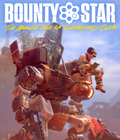Combining base building, farming, and mech action may sound like an odd mix, but that's the basis for DINOGOD's Bounty Star. You play as Clem, an ex-soldier who is trying to rebuild her life after some unknown bad decision in her past. In this future version of the American West (the developers are calling it the post-post-apocalypse), war and climate change have ravaged the land. Clem has taken up residence in an old service station, which serves as your base of operations. The Bounty Star TGS demo gave me a chance to explore the base, inspect the farming area, and take on two missions to shoot bad guys for cash.
Because the demo was short, I didn't get to do a whole lot of base building (or upgrading), but there is potential. For the demo, the base appeared to be fully powered, but I'm guessing that won't be the case when you first start playing. Inspecting the power plant, it looks like the Electrolyzer, Griddle, Merchant Terminal, Paint Station, and Toaster all need to be powered by batteries. If there's no battery, there's no power. If there's no power, you can't use it. It's not clear if these are permanent selections or if you can swap batteries as needed until they're fully charged.
Powering up the Electrolyzer allows you to produce fuel, which means you don't have to pay for it out of your bounty profits. The Griddle and Toaster are used to cook food, which grants temporary stat buffs (Monster Hunter fans will be familiar with this mechanic). The Merchant Terminal allows you to buy and sell items as needed, while the Paint Station lets you customize the look of your mech.
Cooking requires both recipes and ingredients, which you can find or buy. For the demo, I defaulted to buying things (it was just faster), but exploring the farm area outside of Clem's base makes it clear that growing your own supplies will likely be preferred. It'll also be cheaper over the long run. Just like making fuel with the Electrolyzer, I was able to harvest cactus fruit and cactus meat, which are ingredients in the Sweet Cactus Salad recipe. The farm area also had what I'm guessing were baby corn stalks, chickens (which required corn and water), and a cute lizard thing called microtheros (which required meat and water).
Yes, you can pet the animals.
Before heading out on a bounty mission, you'll want to customize your mech, known as a Raptor. The Raptor can be equipped with two sets of melee weapons and ranged weapons, as well as the accompanying support systems. The two loadouts are always available, and you can swap between them at the press of a button. Weapons and support systems can be crafted or acquired, and it's important to have a variety because you'll need to match weapons to enemies if you want to do real damage. You will want to craft ammunition if you have the resources because, just like fuel, crafting is cheaper than paying for ammo expenses out of your bounty profits.
There are three weapon types (Blade, Bludgeon, and Boom) and three enemy hit point types (Plate, Scales, Skin). Plate is vulnerable to Boom, neutral against Blade, and strong against Bludgeon. Scales are vulnerable to Bludgeon, neutral against Boom, and strong against Blade. Skin is vulnerable to Blade, neutral against Bludgeon, and strong against Boom. It's straightforward, but it's also something that you have to keep in mind, especially when facing stronger enemies.
Starting a bounty mission is as simple as picking it from a map and then deploying your Raptor. Bounty Star is not an open-world game, so you don't have to manually travel to your destination.
Each of the two bounty locations in the demo was within a canyon. Transparent barriers blocked the outward passage, so fights were contained. Your Raptor is fast and nimble, giving combat an arcade feel. These are not slow, lumbering mechs. You'll need to make the most of that agility when navigating threats on multiple fronts. For example, taking cover behind a rock formation is a good way to get a solid object between you and a lock-on projectile that's heading your way.
Opponents consisted of humans, other mechs, and robots. Surprisingly, the human snipers were the most annoying enemies to deal with. While just as vulnerable as other humans, they're small targets and they pack quite a punch. The other mechs could deal out damage, but it was usually much easier to spot them at a distance.
In between shooting and dodging, you also have to keep an eye on your Raptor's temperature. It wasn't an issue in the demo, but I'm guessing it'll be another thing to manage in the full version of the game. An overheated mech is never a good thing. Speaking of shooting, the demo combat was mech only, but Clem did have her own gun at the base, so I wouldn't be surprised if there is also some on-foot combat in the game.
The TGS demo only offered a small peek at Bounty Star, but it was enough to garner interest. I'm curious to see how the base upgrade and farming aspects develop over time, not to mention what kind of punch a fully decked-out Raptor can pack. Check back next month for our full review.
More articles about Bounty Star: The Morose Tale of Graveyard Clem











 Bounty Star is an over-the-shoulder 3D action game that marries mech combat and customization with farming and base building.
Bounty Star is an over-the-shoulder 3D action game that marries mech combat and customization with farming and base building.



































